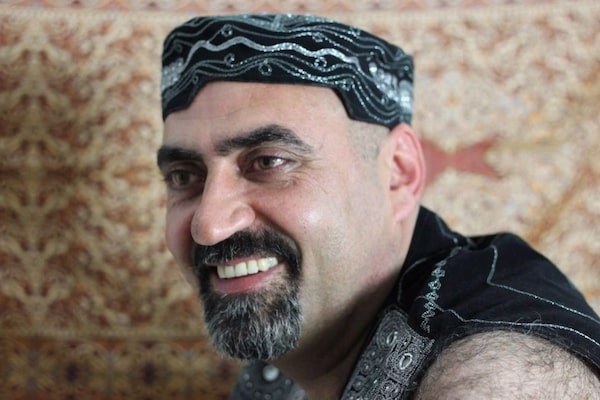
Abdulbasir Faizi is shown in a Toronto Police Service handout photo.The Canadian Press
Alleged serial killer Bruce McArthur is now facing a seventh charge of first-degree murder as the investigation into the disappearances of men from Toronto’s Gay Village widens, with police preparing to search some 75 properties and reopening 15 homicide cold cases.
The 66-year-old landscaper appeared by video in a Toronto courtroom on Wednesday morning, where the new charge was filed in relation to the death of Abuldbasir Faizi, who disappeared in late 2010.
Police have finished searching garden planters from a Toronto property, and have identified six of the seven men whose body parts were found there.
Alleged serial killer Bruce McArthur is facing a seventh first-degree murder charge, as Toronto police say the remains of three more men have been identified. McArthur was charged Wednesday in the death of Abdulbasir Faizi.
The Canadian Press
In an update on the case at Toronto Police Service headquarters on Wednesday, Detective-Sergeant Hank Idsinga told reporters police believe there is at least one more victim, who is unidentified, and that other remains may be at another location.
The investigator also confirmed that police do not know where the garden planters were before 2015, around the time the owners of the property, in Toronto’s Leaside neighbourhood, say Mr. McArthur delivered them to their home.
Although police searched dozens of properties connected to Mr. McArthur’s landscaping business with police dogs, but found little, the list has grown to 75 locations and they hope to begin more extensive searches in early May, once the ground has warmed. Det.-Sgt. Idsinga said two of the properties could have more victims, but investigators do not know how many.
“We really don’t know how deep this is going to go,” Det.-Sgt. Idsinga said. “I don’t want to hazard putting a final number on it.”
The six men who have been identified thus far are Dean Lisowick, Selim Esen, Skandaraj Navaratnam, Soroush Mahmudi and Andrew Kinsman, whose deaths Mr. McArthur was charged with previously, as well as Mr. Faizi.
The death of Majeed Kayhan has also been attributed to Mr. McArthur, although police have yet to find his DNA or any identifying features in the planters.
Det.-Sgt. Idsinga also released new images, an enhanced photo and an artist’s rendering, of a man who they believe was murdered by Mr. McArthur. Despite 500 tips, the man has yet to be identified. Police had narrowed down those tips to a list of 22 men who could be the one in the photo.
The widening investigation has also pushed police to sift through 15 cold-case homicides between 1975 and 1997, although Det-Sgt. Idsinga said all of them might not be linked to the McArthur case. Investigators are reviewing any case that may be connected to the Gay Village or the LGBTQ community, although Det.-Sgt. Idsinga said that police have yet to find a connection to Mr. McArthur.
Mr. Faizi, who was born in Afghanistan, was living with his wife, Kareema, and their two daughters in Brampton, west of Toronto, when he disappeared in December, 2010. He was last seen in the Village, according to a police missing person report.
His wife filed for divorce in 2012, thinking Mr. Faizi had become estranged and wanted to escape financial problems. “The investigators felt that he had abandoned his family and did not want to be found,” she said in a court affidavit. She believed that until last week.
Ms. Faizi said in a phone interview on Wednesday that she had thought Mr. Faizi was “living somewhere with someone else.” Eight days ago, Toronto police contacted her, visited the next day and confirmed his death.
She said she was too distraught to hear more details beyond the fact that only partial remains of her husband were recovered.
“I’m not feeling good,” she said. “Every day I’m crying when I am home.”
Toronto police have now obtained DNA from her daughters, she said.
Mr. Faizi’s case was investigated by the Toronto Police Service in 2013 as a part of Project Houston, a task force set up to look into the disappearance of Mr. Navaratnam four months before Mr. Faizi vanished.
Police included the disappearances of Mr. Faizi and Mr. Kayhan when Mr. McArthur came across their radar. Officers brought the landscaper in for questioning in 2013, although he was not considered a suspect.
Mr. Faizi had worked in a print shop, but filed for bankruptcy early in 2010, saying he had been the victim of mortgage fraud.
On Dec. 29, he was supposed to work until 7 p.m. Around 7:20 p.m., he phoned his wife and told her he would be late. He never came home, and his phone was turned off shortly after his last call.
Police later found that he had spent the evening at the Black Eagle, a Church Street gay bar where he was a regular that Mr. McArthur was also known to patronize.
After leaving the bar, Mr. Faizi went to Steamworks, a men-only bathhouse. According to bank records, he bought a burger across the street after leaving.
Because he was reported missing from Brampton, Peel Regional Police investigated. His car was found early in the new year north of the Village, on Moore Avenue, near the Mallory Crescent house where police found the human remains.
When she reported her husband missing, Ms. Faizi told Peel police he showed no signs of depression or suicidal thoughts. “Her husband has no enemies and no reason for anyone to want to kidnap him,” said a police report from Jan. 1, 2011.
In April of 2014, less than a year after Mr. McArthur was interviewed, Project Houston was disbanded.
Asked on Wednesday whether the service has any regrets about Project Houston, Det.-Sgt. Idsinga, who worked on it for a time, said no. “Hindsight is always 20-20,” he said, adding: “I’m quite content with the job that was done.”
 Tu Thanh Ha
Tu Thanh Ha